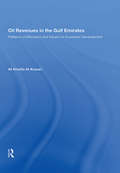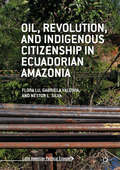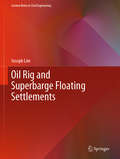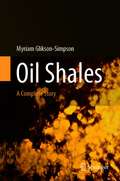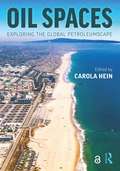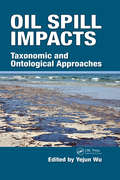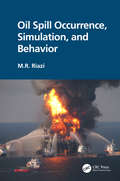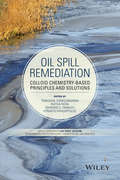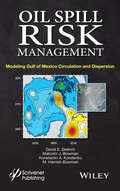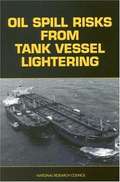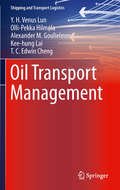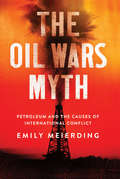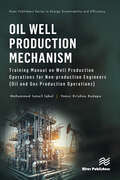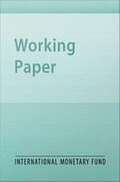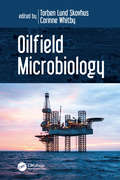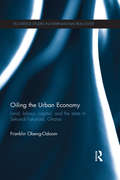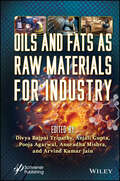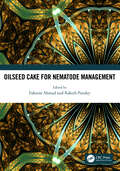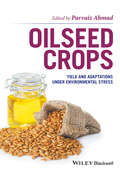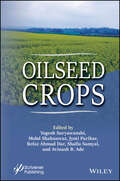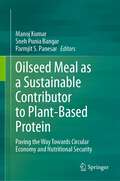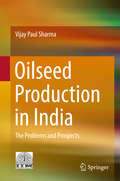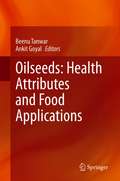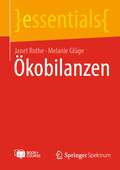- Table View
- List View
Oil Revenues In The Gulf/h
by Ali Khalifa Al-KuwariThis book is a major contribution to our understanding of the Gulf Emirates, illuminating many aspects of the socio-economic forces and processes operating on and in the region. It assesses actual oil revenues received and shows the impact oil revenues have had on economic development.
Oil, Revolution, and Indigenous Citizenship in Ecuadorian Amazonia
by Gabriela Valdivia Flora Lu Néstor L. SilvaThis book addresses the political ecology of the Ecuadorian petro-state since the turn of the century and contextualizes state-civil society relations in contemporary Ecuador to produce an analysis of oil and Revolution in twenty-first century Latin America. Ecuador's recent history is marked by changes in state-citizen relations: the election of political firebrand, Rafael Correa; a new constitution recognizing the value of pluriculturality and nature's rights; and new rules for distributing state oil revenues. One of the most emblematic projects at this time is the Correa administration's Revoluci#65533;n Ciudadana, an oil-funded project of social investment and infrastructural development that claims to blaze a responsible and responsive path towards wellbeing for all Ecuadorians. The contributors to this book examine the key interventions of the recent political revolution--the investment of oil revenues into public works in Amazonia and across Ecuador; an initiative to keep oil underground; and the protection of the country's most marginalized peoples--to illustrate how new forms of citizenship are required and forged. Through a focus on Amazonia and the Waorani, this book analyzes the burdens and opportunities created by oil-financed social and environmental change, and how these alter life in Amazonian extraction sites and across Ecuador.
Oil Rig and Superbarge Floating Settlements (Lecture Notes in Civil Engineering #82)
by Joseph LimThis book presents a collection of proposed offshore and nearshore settlements in response to the emerging consequences of climate change. These settlements are counterpoints to megacities with unsustainable ecological footprints. The continuing depletion of natural resources has resulted in displaced communities, prompting the following research questions: What if we floated on sea instead of inefficiently consuming land? Could we use wave energy instead of nuclear energy? How can we replenish food supply and regenerate marine eco-diversity? How would our lives be shaped by new offshore settlements? What would we use as structures for shelter, farming, scaffolding and recreation? Floating cities emerged in the 1960s with Buckminster Fuller’s Triton City and Kenzo Tange’s Tokyo Bay Plan, and current manifestations include Vincent Callebaut’s Lilypad, the Seasteading Institute and the mile-long Freedom Ship housing 50,000 people. As an alternative to these examples, the book proposes the repurposing of three types of marine vessel: jack-up platforms, semi-submersibles and superbarges as sustainable, habitable structures to accommodate 20% of the projected 8.1 billion global population in 2025. The spatially conceived floating settlements include food and energy supplies for housing, recreation, education at sea, post-disaster health care and resettlement for nearshore deployment.
Oil Shales: A Complete Story
by Miryam Glikson-SimpsonThis book provides thorough knowledge and detailed information of oil shales using a range of conventional and unconventional techniques and methodologies combined to elucidate the composition of oil shale deposits. As these rocks are mined for energy production their composition and mineral constituents are of special interests to individuals and communities that are likely to be effected by these resources when mined and processed. The book highlights the environmental and health hazards of the spent shales after processing. These are significantly greater in volume than the rocks originally mined before processing. Toxic metals tend to double and triple their concentrations in the spent shales and will be leached into water sources and soils.Since oil shales as an energy resource are totally uneconomical; all oil shales, their mining and processing are heavily subsidised by governments and institutions using taxpayers money.
Oil Spaces: Exploring the Global Petroleumscape
by Carola HeinOil Spaces traces petroleum’s impact through a range of territories from across the world, showing how industrially drilled petroleum and its refined products have played a major role in transforming the built environment in ways that are often not visible or recognized. Over the past century and a half, industrially drilled petroleum has powered factories, built cities, and sustained nation-states. It has fueled ways of life and visions of progress, modernity, and disaster. In detailed international case studies, the contributors consider petroleum’s role in the built environment and the imagination. They study how petroleum and its infrastructure have served as a source of military conflict and political and economic power, inspiring efforts to create territories and reshape geographies and national boundaries. The authors trace ruptures and continuities between colonial and postcolonial frameworks, in locations as diverse as Sumatra, northeast China, Brazil, Nigeria, Tanzania, and Kuwait as well as heritage sites including former power stations in Italy and the port of Dunkirk, once a prime gateway through which petroleum entered Europe. By revealing petroleum’s role in organizing and imagining space globally, this book takes up a key task in imagining the possibilities of a post-oil future. It will be invaluable reading to scholars and students of architectural and urban history, planning, and geography of sustainable urban environments.
Oil Spill Impacts: Taxonomic and Ontological Approaches
by Yejun WuStarting with the 2010 Gulf of Mexico Deepwater Horizon oil spill incident, Oil Spill Impacts: Taxonomic and Ontological Approaches chronicles a timeline of events that focus on the impact of oil spills and provides an understanding of these incidents using a number of approaches. The book includes an interdisciplinary oil spill taxonomy, an
Oil Spill Occurrence, Simulation, and Behavior (Fuels and Petrochemicals)
by M.R. RiaziOil Spill Occurrence, Simulation, and Behavior provides practical insight into oil spills and their causes, impacts, response and cleanup methods, simple and advanced modeling of oil spill behavior, and oil spill simulation techniques. Discusses various sources of oil spills and major accidents Includes case studies on the 2010 Gulf of Mexico oil spill, including environmental, economic, and political impacts, modeling and behavior as well as response and cleanup methods Introduces some commercial softwares on predicting oil movement and spreading on water Describes properties and characteristics of crude oil and its products needed for simulation and prediction of behavior of an oil slick Written as an applied book with minimal math and theory, making it accessible to a wide range of readers The book includes more than 100 unique and informative images in color This essential book is aimed at professionals, academics, and scientists in the fields of chemical engineering, petroleum engineering, environmental engineering, marine and ocean engineering working on the simulation and modeling, mitigation, and prevention of oil spills.
Oil Spill Remediation
by Ponisseril Somasundaran Kyriakos Papadopoulos Partha Patra Raymond S. FarinatoThis book provides a comprehensive overview of oil spill remediation from the perspectives of policy makers, scientists, and engineers, generally focusing on colloid chemistry phenomena and solutions involved in oil spills and their cleanup.* First book to address oil spill remediation from the perspective of physicochemical and colloidal science* Discusses current and emerging detergents used in clean-ups* Includes chapters from leading scientists, researchers, engineers, and policy makers* Presents new insights into the possible impact of oil spills on ecosystems as well as preventive measures
Oil Spill Risk Management: Modeling Gulf of Mexico Circulation and Oil Dispersal
by Malcolm J. Bowman David E. Dietrich M. Hamish Bowman Konstantin A. KorotenkoThis book is designed to help scientifically astute non-specialists understand basic geophysical and computational fluid dynamics concepts relating to oil spill simulations, and related modeling issues and challenges. <P><P>A valuable asset to the engineer or manager working off-shore in the oil and gas industry, the authors, a team of renowned geologists and engineers, offer practical applications to mitigate any offshore spill risks, using research never before published.
Oil Spill Risks from Tank Vessel Lightering
by Committee on Oil Spill Risks from Tank Vessel LighteringStudy focuses narrowly on the risks of oil spills from lightering, which was defined as the transfer at sea of crude oil or petroleum products from one vessel to another. Paper.
Oil Transport Management
by Kee-Hung Lai Alexander M. Goulielmos T.C. Edwin Cheng Olli-Pekka Hilmola Y.H. Venus LunThe first volume in a new Springer Series on Shipping and Transport Logistics, Oil Transport Management provides a full historical account of the evolution of the oil transport industry since the 1800's. In this comprehensive guide, the authors investigate the industry and describe the shipping market and its structure, as well as forecasting, location plan and the transportation chain. They dedicate a separate chapter to each topic to cover various concepts, including: an introduction to the tanker shipping market, including how the freight, new vessel building, second hand and demolition markets influence one another, the economic structure and organization of the tanker industry in both the past and present, and forecasting the need for oil-based sea transportation. Further chapters present case studies and simulations to illustrate the importance of factory location decisions and the need for oil infrastructure investments. Chapter One also includes a regression equation to predict the fleet size in tanker shipping. Oil Transport Management is a key reference, which can be practically applied to wider global research and practices. Ideal for both industry practitioners, and researchers and students of shipping studies, Oil Transport Management provides a concise yet comprehensive coverage of the oil transport industry's history and a guide for its future development.
The Oil Wars Myth: Petroleum and the Causes of International Conflict
by Emily MeierdingDo countries fight wars for oil? Given the resource's exceptional military and economic importance, most people assume that states will do anything to obtain it. Challenging this conventional wisdom, The Oil Wars Myth reveals that countries do not launch major conflicts to acquire petroleum resources. Emily Meierding argues that the costs of foreign invasion, territorial occupation, international retaliation, and damage to oil company relations deter even the most powerful countries from initiating "classic oil wars." Examining a century of interstate violence, she demonstrates that, at most, countries have engaged in mild sparring to advance their petroleum ambitions.The Oil Wars Myth elaborates on these findings by reassessing the presumed oil motives for many of the twentieth century's most prominent international conflicts: World War II, the two American Gulf wars, the Iran–Iraq War, the Falklands/Malvinas War, and the Chaco War. These case studies show that countries have consistently refrained from fighting for oil. Meierding also explains why oil war assumptions are so common, despite the lack of supporting evidence. Since classic oil wars exist at the intersection of need and greed—two popular explanations for resource grabs—they are unusually easy to believe in.The Oil Wars Myth will engage and inform anyone interested in oil, war, and the narratives that connect them.
Oil Well Production Mechanism: Training Manual on Well Production Operations for Non-production Engineers (Oil and Gas Production Operations) (River Publishers Series in Energy Sustainability and Efficiency)
by Mohammed Ismail Iqbal Vamsi Krishna KudapaThis is a comprehensive guide to the intricacies of the oil and gas industry, focusing specifically on production processes. Written by industry experts, the book offers valuable insights into the technical aspects, environmental considerations, and economic factors associated with oil and gas exploration and extraction.Main topics covered: Introduction to the oil and gas industry: The book overviews the industry, including its historical background, global significance, and key players. Basic reservoir concepts: It explores the techniques and technologies used to identify potential oil and gas reserves, assess their commercial viability, and estimate their production potential. Well completion and construction, intervention: The book delves into the various well completion processes, methodologies, construction and well intervention techniques, and reasons. This section focuses on completing the drilled wells and initiating production. It covers completion techniques, wellbore stimulation, artificial lift methods, and production optimization. Emerging technologies and future trends: It highlights the latest advancements in drilling and production technologies, such as directional drilling, hydraulic fracturing, and digitalization. It also discusses the industry's prospects and challenges. Oil Well Production Mechanism serves as a valuable resource for professionals, students, and enthusiasts seeking a comprehensive understanding of the oil and gas industry's production processes. It combines technical knowledge with practical insights, making it an essential read for anyone involved or interested in this dynamic field.
Oil Windfalls in Ghana: A DSGE Approach
by Jihad Dagher Jan Gottschalk Rafael PortilloA report from the International Monetary Fund.
Oilfield Microbiology: Proceedings From The International Symposium On Applied Microbiology And Molecular Biology In Oil Systems (ismos-2) 2009
by Torben Lund Skovhus Corinne WhitbyMicroorganisms can be both beneficial and harmful to the oil and gas industry and therefore there is an increasing need for the oil industry to characterize, quantify and monitor microbial communities in real time. Oilfield Microbiology offers a fundamental insight into how molecular microbiological methods have enabled researchers in the field to analyze and quantify in situ microbial communities and their activities in response to changing environmental conditions. Such information is fundamental to the oil industry to employ more directed, cost-effective strategies to prevent the major problems associated with deleterious microbial activities (e.g., souring and biocorrosion), as well as to encourage beneficial microbe activity (e.g. oil bioremediation). The aim of the book is to understand how the technological advances in molecular microbiological methods over the last two decades are now being utilized by the oil industry to address the key issues faced by the sector. This book contains a comprehensive collection of chapters written by invited experts in the field from academia and industry and provides a solid foundation of the importance of microbes to the oil and gas industry. It is aimed at microbial ecologists, molecular biologists, operators, engineers, chemists, and academics involved in the sector.
Oiling the Urban Economy: Land, Labour, Capital, and the State in Sekondi-Takoradi, Ghana (Routledge Studies in International Real Estate)
by Franklin Obeng-OdoomThis book presents a critical analysis of the ‘resource curse’ doctrine and a review of the international evidence on oil and urban development to examine the role of oil on property development and rights in West Africa’s new oil metropolis - Sekondi-Takoradi, Ghana. It seeks answers to the following questions: In what ways did the city come into existence? What changes to property rights are oil prospecting, explorations, and production introducing in the 21st century? How do the effects vary across different social classes and spectrums? To what extent are local and national institutions able to shape, restrain, and constrain trans-national oil-related accumulation and its effects on property in land, property in housing (residential, leisure, and commercial), and property in labour? How do these processes connect with the entire urban system in Ghana? This book shows how institutions of varying degrees of power interact to govern land, housing, and labour in the city, and analyses how efficient, sustainable, and equitable the outcomes of these interactions are. It is a comprehensive account of the tensions and contradictions in the main sectors of the urban economy, society, and environment in the booming Oil City and will be of interest to urban economists, development economists, real estate economists, Africanists and urbanists.
Oils and Fats as Raw Materials for Industry
by Divya Tripathy Anjali Gupta Pooja Agarwal Anuradha Mishra Arvind JainOILS AND FATS AS RAW MATERIALS FOR INDUSTRY This new volume emphasizes the sources, structure, chemistry, treatment, modification, and potential applications for oils and fats as raw materials in industry. Oils and fats can be used as raw materials in many industries including food and agriculture, as surfactants in laundry detergents and cosmetics, as well as in pharmaceuticals. Moreover, unsaturated vegetable oils are also suitable to form epoxides and hence, are important in the manufacturing of paints and adhesives. Limited sources of petrochemicals and their harmful effects on health and the environment also promote the use of naturally occurring oils and fats as biodiesel after some chemical modification. Moreover, a vast variety of nonedible oils that can be obtained from easily cultivable plant species are receiving great interest from researchers because they not only yield cost-effective products but are also proven as a substrate to promote sustainable research. In this book, the editors will cover all possible industrial applications of the products that are formed using edible and non-edible vegetable oils. Vegetable oils are not a new research area, although they are considered an evergreen or long-lasting topic as most of the research in synthetic chemistry has been carried out on vegetable oils.
Oilseed Cake for Nematode Management
by Faheem Ahmad Rakesh PandeyPlant-parasitic nematodes (PPNs) devastate many crop plants, causing billions of dollars in agricultural losses each year. Effective management methods to combat PPNs are synthetic nematicides, but most are non-specific and notoriously toxic and threaten the soil ecosystem, groundwater and human health. The plant by-products, such as oilseed cakes, are sources of bioactive compounds with nematicidal potential. Oilseed cakes are an excellent organic fertilizer, and their bioactive compounds are now gaining importance as they are safe for the environment. This book provides the most comprehensive and up-to-date review of research on the use of oilseed cakes against PPNs. The complete knowledge of better uses of oilseed cakes for nematode management is necessary for developing effective nematode control options to reduce yield loss. Key features: • Describes plant by-products such as oilseed cakes and their potential applications • Explores bioactive compounds from oilseed cakes for agricultural biofertilization and nematicidal activity • Discusses nematode management in vegetable, fruit and legume crops • Covers the use of oilseed cakes and management of the associated challenges This volume is designed and edited to serve as an invaluable resource text for readers associated with plant nematology, plant pathology, plant protection and agricultural science, including researchers, teachers, advanced undergraduates and graduate students and even agricultural extension agents and farmers.
Oilseed Crops: Yield and Adaptations under Environmental Stress
by Parvaiz AhmadOil Seed Crops: Yield and Adaptations under Environmental Stress is a state-of-the-art reference that investigates the effect of environmental stress on oil seed crops and outlines effective ways to reduce stress and improve crop yield. With attention to physiological, biochemical, molecular, and transgenic approaches, the chapters discuss a variety of oil seed crops and also cover a broad range of environmental stressors including microbes, salt, heavy metals, and climate change. Featuring up-to-date research from a global group of experts, this reference provides innovative recommendations for mitigating environmental stress and promoting the healthy growth, development, and adaptation of crops.
Oilseed Crops
by Yogesh Suryawanshi Mohd Shahnawaz Jyoti Parihar Refaz Ahmad Dar Shallu Samyal Avinash B. AdeOilseed Crops offers essential insights into sustainable biotechnological advancements that are vital for enhancing oil production and meeting the skyrocketing global demand for food, fuel, and energy. Plants, particularly oilseed crops, have played a crucial role in biotechnology since the early 20th century, providing sustainable resources for food, fodder, and fuel. The book “Oilseed Crops” delves into using biotechnological methods to enhance both edible and non-edible oils sustainably. It offers an in-depth look at the global oil plant market, growth influencers, adulteration detection, and yield improvement strategies. Highlighting significant advancements in oilseed research—such as plant-microbe interactions, drought-resistance, and molecular biotechnologies—the book focuses on increasing oil yields and discusses the production of biofuels from non-edible oilseeds to meet rising biofuel demands.
Oilseed Meal as a Sustainable Contributor to Plant-Based Protein: Paving the Way Towards Circular Economy and Nutritional Security
by Manoj Kumar Sneh Punia Bangar Parmjit S. PanesarProtein is one of the most important ingredients of the human diet and is considered crucial for the growth development of all age groups. Studies have set the recommended dietary allowance of protein as 0.8 g/kg body weight per day for healthy adults. The world population is projected to reach 10 billion by 2050 and it will be a significant challenge for the scientific community to overcome the growing demand for protein. The results of global warming, from shifting climactic conditions to unpredictable rainfalls, have further complicated the situation. The search for alternative protein sources that can be both sustainable and renewable is one of the major challenges in the face of potential mass protein malnutrition. Oilseed crops such as soybean, mustard, oil palm, peanuts, cottonseed, flax seed, coconut, canola and sesame are mainly cultivated for the extraction of cooking oil and are underutilized as sources of protein. Oilseed meals contain as much as 50% protein but remain under-valued since they are traditionally utilized as fertilizer or as feed for livestock animals. Numerous recent studies show that oilseed meal sources can be utilized as a sustainable and renewable source of protein and could play a major role in alleviating the global problem of protein malnutrition. Oilseed Meal as Sustainable Contributor to Plant-Based Protein explores oilseed crops that can contribute towards the regular supply of protein in an increasing population and changing climate. Each chapter focuses on a specific oilseed crop including comprehensive coverage of the processing and extraction specifics for each crop plus their amino acid profiles and other functional properties. The application of oilseed proteins for production of bioactive peptides and preparation of value-added products is also covered. This text is useful for food scientists and researchers seeking an updated single source for coverage on all the most important oilseed crops andtheir potential roles in combating protein shortages in a growing world population.
Oilseed Production in India
by Vijay Paul SharmaThis book analyses the performance and potential of India's oilseed sector, identifies the major constraints facing the industry and suggests options for increasing the country's oilseed production and productivity, taking into account the changing policy environment, increasing demand, slow growth in domestic production and rising imports. India as the world's largest producer of oilseeds, accounts for about 7-8 per cent of global vegetable oil production. However, the growth in domestic production has not kept pace with the growth in demand. Low yields and high production and market risks due to lack of irrigation facilities and effective risk management have been responsible for widening the demand-supply gap over the years, and the country now imports more than half of its oilseed for domestic consumption. The Technology Mission on Oilseeds (TMO), launched in the mid-1980s, helped achieve self-sufficiency in edible oil production through the spread of technology and the provision of market support. However, increasing demand for edible oils necessitated imports in large quantities, leading to a substantial drain on foreign exchange. Given the competing demands on agricultural land from various crops and enterprises, the production of oilseeds can be increased only if productivity is improved significantly and farmers receive remunerative prices and have assured market access. However, farmers face various constraints in oilseed production; several biotic, abiotic, technological, institutional and socio-economic constraints inhibit exploitation of the full yield potential of crops, which need to be addressed. The book explores these issues using data collected from about 2,000 oilseed growers: 490 soybean farmers, 316 rapeseed-mustard growers, 470 groundnut farmers, 250 sesamum farmers and 470 sunflower growers from selected Indian states. It would be of immense use for scholars and policy makers alike who are working in this field.
Oilseeds: Health Attributes and Food Applications
by Beenu Tanwar Ankit GoyalOilseeds offer a plethora of opportunities for the food and feed industry, thanks to their high oil and protein content . Their phytonutrients and functional components have attracted the interest of researchers, leading to the development of functional foods. This book gathers the latest scientific information on the nutrients, phytonutrients and health benefits as well as the adverse effects of consuming various conventional and non-conventional oilseeds. In addition, each chapter includes a section comprehensively explaining the use of oilseeds in functional bakery, dairy, and other food products. Given its scope, the book is a valuable resource for students, researchers, nutritionists, food scientists and technologists, and for anyone involved in product development based on oilseed and its components.
Ojos que no ven… Guía para dominar la perspectiva narrativa
by Natalia Steckel Ken Pelham¿Cómo te quitas tus anteojos de perspectiva de escritor y expresas lo que un personaje ficticio ve, oye, piensa y experimenta? ¿Cómo mantienes una perspectiva coherente? ¿Cómo evitas que el hechizo narrativo que creaste se rompa y tu lector diga: "Un momento... ¿Qué?". Una de las habilidades de escritura más difíciles de comprender es la de escribir desde el punto de vista de los personajes de ficción. Un libro imprescindible para escritores de ficción y de no ficción, Ojos que no ven... Guía para dominar la perspectiva narrativa, enseña con ejemplos cómo detectar --y, más importante aún, cómo corregir-- errores de perspectiva evidentes y no tan evidentes.
Ökobilanzen (essentials)
by Janet Rothe Melanie GlügeSeit der Industrialisierung im 18. Jahrhundert haben sich Ansprüche an Produkte und ihre Produktionsweise geändert. Kunden sind sich im 21. Jahrhundert der Tragweite ihrer Kaufentscheidung bewusster, sodass Hintergrundwissen zu Produktionsbedingungen und Lieferketten eine immer wichtigere Rolle spielen. Mit Hilfe von Produkt-Ökobilanzen ist eine Ermittlung von umweltschonenderen Produktionsverfahren möglich. Ziel dieses Buches ist es, Ihnen diese Ermittlungsverfahren einfach und praxisnah zu erklären. Wie erstellt man eine Ökobilanz? Anhand von realistischen Beispielen wird gezeigt, wie eine Ökobilanz aufgebaut ist, wie bilanziert und berechnet wird.
